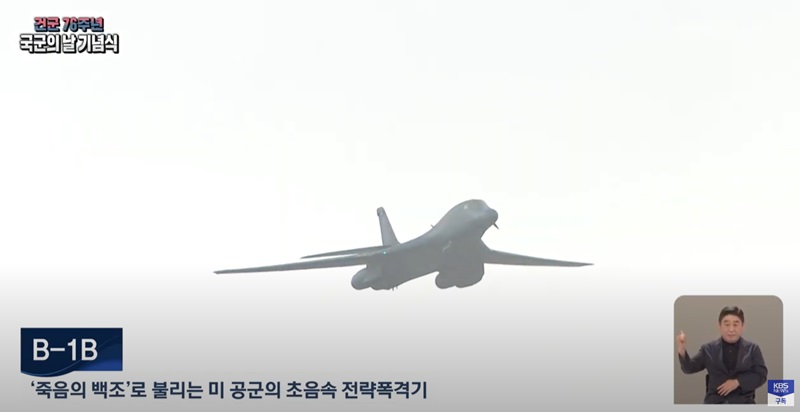On October 1, the U.S. Air Force deployed a B-1B Lancer long-range bomber over Seoul as part of South Korea’s Armed Forces Day celebrations. Prior to the event, North Korea had hinted at potential provocations in response to the bomber’s deployment to the Korean Peninsula.
The B-1B, believed to have flown in from the U.S. mainland, appeared over Seoul Air Base at around 11:38 a.m., escorted by two F-15 fighter jets. It marked the final segment of the Armed Forces Day ceremony.
Nicknamed the “Swan of Death” in South Korea, the B-1B Lancer is one of the U.S.’s key strategic assets, alongside the B-52 and B-2 bombers. Capable of flying at supersonic speeds, the B-1B can reach the Korean Peninsula from Guam in just two hours, traveling at Mach 1.25 (1,530 km/h). It can carry up to 61 tons of bombs and missiles both inside and outside the aircraft.

Although deploying the B-1B for last year’s Armed Forces Day was considered, the plan was ultimately canceled. However, in June of this year, the bomber participated in joint air drills with the South Korean Air Force, including precision-guided bomb drops, marking the first time in seven years such exercises took place.
On the same day, North Korea condemned the deployment of the B-1B, with Kim Kang-il, Vice Minister of the Ministry of National Defense, issuing a statement through the Korean Central News Agency.
He criticized the U.S. for what he called a “bluffing military demonstration” and threatened a corresponding response. He further dismissed the deployment as an “illusionary attempt to maintain military dignity in the face of their strategic inferiority in the region.”
Kim also referenced the frequent presence of U.S. strategic assets in the region, including the B-1B and the USS Theodore Roosevelt, which docked in Busan in June, emphasizing that North Korea is fully prepared to safeguard its national security.

In addition to the B-1B, the Armed Forces Day event featured a variety of military displays, including tactical aerial maneuvers by F-15K and F-35A fighter jets, a taekwondo demonstration by special forces, and a joint high-altitude jump by the army, navy, and air force.
The final segment showcased a range of military assets, including Apache helicopters, ground forces, unmanned and manned combat systems, and fixed-wing aircraft.
Notably, the ceremony also marked the first public unveiling of the Hyunmoo-5 ballistic missile, a key component of South Korea’s “Korea Massive Punishment and Retaliation” (KMPR) system, part of its three-axis defense strategy.
Over 5,300 troops and 340 pieces of military equipment participated in the ceremony, which concluded with a street parade under the theme, “Strong Military, Together with the People.”
BY MUNGYU CHO, YOUNGNAM KIM [chomg@joongang.co.kr]




